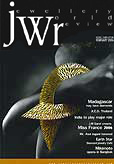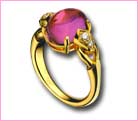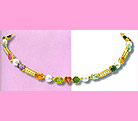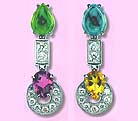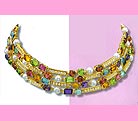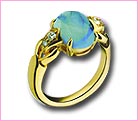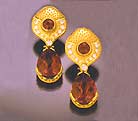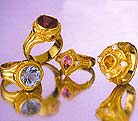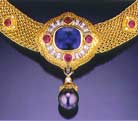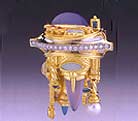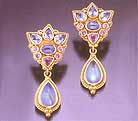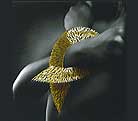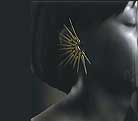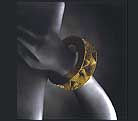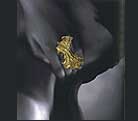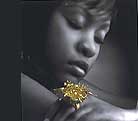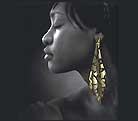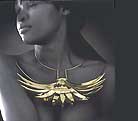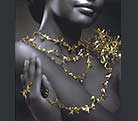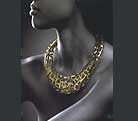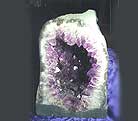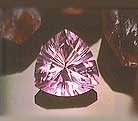 |
||
| BULGARI'S ALLEGRA COLLECTION
SPRINGING FROM NATURE |
||||||||||||||||||||||||||||||
Bulgari opened its first shop in Rome in 1879. The Company's highly distinctive style is inspired by Greek and Roman classicsm, the Italian Renaissance and 19th century Roman goldsmiths. As its fame spread internationally, the Company opened stores in New York, Paris, Geneva and Monte Carlo with great success. Bulgari now has over 150 stores worldwide. The Company's ongoing success is largely due to its understanding that the evolution of style must follow changes in times, tastes and habits. The Bulgari style is a balanced mix of classicism and modernity in a continuous search for innovative design and materials, with a special attention towards colour combinations. Never has this more evident than with Bulgari's Allegra Collection. Allegra-from the feminine of the Italian word meaning happy- has sprung from nature. It provides a kaleidoscope of colour and unconventional designs. It whispers happiness to the wearer, and offers a new light-ness of being. Through the power of the gemstones Allegra reflects a joyful mood, exuding the positive energy of the earth, and the rich, natural warmth of colours felt when in a tropical garden under the rays of an intense, bright sun. |
||||||||||||||||||||||||||||||
|
||||||||||||||||||||||||||||||
| KENT RAIBLE ARTISTIC JOURNEYS | ||||||||
Since
1971, jewelry designer Kent Raible has continuously worked with and studied
the history of precious metals. He is now recognized as one of America
's preeminent studio goldsmiths. Inspired by the intricate and o pulent
gold work of antiquity, Kent 's unique contemporary art pieces are often
created using techniques that have been in use for thousands of years,
using relatively simple sols. Kent Raible's dedication to his craft has earned him international recognition through awards, museum acquisitions, and commissions. His one-of-a-kind Master- works as well as his Studio Collection of designer jewelry are available through fine art galleries and jewelry stores across the US . Kent was born in 1955, in Berkeley California , into a family of artists. He now resides with his wife and son in Nevada City . In 1971 he took his first jewelry class in high school. By the age of 20, Kent was winning awards at art shows in San Francisco , and selling mostly silver items. He won his first national award in 1977, in the Sterling Silver Design Competition. |
||||||||
|
||||||||
| In
1982 Kent traveled to Europe, where hesp? two years; this included two
semesters of guest study Germany, where he worked on his granulation techniq,
After twelve years of metalsmithing, Kent had found' niche. Working exclusively
in granulation, 18K gold 3' colored gemstones, he started to pursue a
serious cafe in jewelry. He then went on to teach granulation workshop
in schools across the country, and won third place in r first international
competition in Germany. Kent met his wife, Lynn, a jewelry buyer, in 19c Two years later, she became his business partner. T her great personality, business experience and nat feel for marketing, Lynn has been a perfect complimeri my artistic sensibilities," says Kent. In 1996, the Rerov; Gallery of the Smithsonian acquired one of Kent's piece Floating City, for its permanent collection. To Kent, the making is an end in itself. Hes still for hours arranging tiny granules of gold into beau" patterns. "I try to find harmony in even the minutest step" the process, whether it's the positioning of a single gre ule, or shaving off a tenth of a millimeter of gold to ge: perfect line. This is the foundation and integrity of mya r he said. |
||||||||
|
||||||||
| Kent
says he has an almost religious fervor for goldsmithing. He is most drawn
to the regal and spiritual themes and the craftsmanship of goldsmiths
past. While paying homage to their artistry, Kent says he likes to "tweak"
history a bit, by adding his own unique contemporary syn thesis to
old archetypes. "I am blessed to be able to work with the rarest and most beautiful of our earth's treasures, and create art in the intimate form of jewelry. Whether I am executing a commission, designing a piece for the Studio Collection, Of making a pvac/a to safety my own crea.tj.ve u.rg,es., I know someone out there is waiting to join me in the artistic journey of that piece," Kent said. Basically a self-taught artist, Kent has studied at a number of institutions in the USA and Germany. From 1978to 1982 he took classes in rendering, gold refining, diamond setting at the renowned Revere Academy in San Francisco. In 1998, Kent studied for a short time with famed gem carver, Glen Lehren Kent buys his fine gold and precious metals from refiners. "I have favorite suppliers for different gems, one for opal, one for pearls, for example. I also buy special stones from award-winning cutters/carvers like Glen Lehrer and Phil Youngman," he said. |
||||||||
|
||||||||
| Kent
is inspired by beauty wherever he finds - in nature, a gemstone, another
person, a work of art in museum. "I tend to observe rather than study
things, the absorb some quality that reemerges later in my work. It largely
an unconscious process of assimilation, combine with intuition and years
of experience in making and desigi ing. I never try to emulate exactly
any particular historic period or style, although there are traces of
these throug out my work," he said. Pieces from Kent's Studio Collection take from to 5 hours to make, larger pieces with hand woven chaii can take up to 50 hours. Masterworks take at least 12 hou for a small ring and up to 600 hours for a more ambitio piece. "And, of course," says Kent, "don't forget the 30 pi years of experience." Kent has five part-time contractc working for him, all of whom he has trained in his style work. Some have been working with him for 8-10 years "My life's path is that of the goldsmith, a path over 30 years now. To say I love my job would be an und' statement. When my creative juices are really flowing, work is closer to a meditation than anything else," said Kent. |
||||||||
| PERFORMANCES IN GOLD ANGLOGOLD ASHANTI AUDITIONS RICHES OF AFRICA JEWELLERY DESIGN COMPETITION | ||||||||
The
lives of three South African designers were changed forever when the winners
of the country's premier gold jewellery design competition, Anglo Gold
Ashanti Au- DITIONS Riches of Africa, were announced recently at a spectacular
function at the Gold of Africa Museum in Cape Town , South Africa . Anglo Gold Ashanti creator of the re-branded and now bi-annual competition, rewarded the designers who had transformed South African gold into manufactured pieces of 18K gold jewellery that expressed the competi tion's theme, "living textures." |
||||||||
|
||||||||
| Early
in 2005 the call for participation went out to South Africa 's jewellery
industry and designers. Workshops were held in country's main centre and
over a thousand designers’ submitted design and technical drawings
for preliminary judging. Twenty-three designs were selected for manu facture - two designers creating more than one winning design - with Anglo Gold Ashanti supplying the gold an; alloys. Manufacturers were appointed to bring the design; to fruition while the designers stayed involved along I way. All finished pieces were submitted for final judging in September 2005 and the 20 designers waited for the final announcement. |
||||||||
|
||||||||
| IIze
Oberholzer of Cape Peninsula University: Technology was awarded the first
prize of R40.000. her winning piece is a bangle of gold veins sweeping
up art around to form the HIV/AIDS ribbon that symbolises tin fight against
the disease. Second prize of R15,000 went to Christy-Anne Bestwick of the Durban Institute of Technology for a lone neckpiece of ferns. The third prize of R10,000 went to Agang Dikgole, a student at the University of Johannesburg, for earrings that mirror the movement of seaweed on the ocean floor. |
||||||||
|
||||||||
One
of the competition's judges, Mary Jane Darroll, said, "I was amazed
at the quality of the competition from She point of view of the entrant
and entry standards. It was particularly insptrtng for me to
observe the translation of renderings into manufactured pieces which in
themselves have created a superior collection of jewellery." Another
of lie competition's judges, jewellery designer Louise Serafini-Swanepoel,
said, "I feel that the collection embodies not only the spirit of
South African jewellery design, but the realisation that we are no longer
followers, but on a par with the leaders in our field." |
||||||||
|
||||||||
| Competition
sponsor AngloGold Ashanti said its sponsorship of gold jewellery design
competitions is based on the company's belief that the market for its
product needs developing and modernising. To achieve this in South Africa
AngioUofef Ashanti encourages etesfgn excellence, develops skills,
and benefits the South African gold jewellery industry through the publicity
this competition attracts and by awarding merit prizes to the institutions
that produce the most winners in a competition.
|
||||||||
|
||||||||
| Since
AngloGold merged with Ashanti Goldfields in 2004, the Riches of Africa
competition has been brought under the new banner of AuDITIONS, which
will be used to brand all jewellery design competitions in which AngloGold
Ashanti is involved worldwide. In addition to South Africa , AuDITIONS
competitions will take place this year in India and Brazil . The 23-piece
South African ensemble will be exhibited worldwide throughout 2006. |
||||||||
| PURPLE... THE COLOR OF ROYATTY | ||||||||
| Amethyst
is the purple variety of quartz and is popular gemstone among those living
in purple madness Although it occurs in massive quantities, a good quail
amethyst can still be pretty costly, especially when the, are set with
diamonds and lots of gold. When choosing?' amethyst, make sure that it
is clear with no apparent crack: lines, and other types of inclusions
within the crystal. Asfc color, go for whichever shade of purple that
sparks yoi fancy. The name "Amethyst" comes from the Greek ar means "not drunken." This was maybe due to a beliefte amethyst would ward off the effects of alcohol, but me likely the Greeks were referring to the almost wine-like cor. of some stones that they may have encountered. Its cc is unparalleled, and even other, more expensive pur: gemstones are often compared to its color and bea/. Although it must always be purple to be amethyst, it can and does have a wide range of purple shades. |
||||||||
|
||||||||
However,
amethyst is not the same everywhere. Different localities can produce
a unique amethyst to that particular region or even to that particular
mine. Experts can often identify the source mine that a particular amethyst
came from. The key to this is the specimen's color, shape of crystal,
inclusions, associations and character of formation. Often cut gems of amethyst are graded using the terms: Siberian, Uruguayan or Bahain; to represent high medium and low grade respectively, regardless of the actual source. Because of the patchyness of the color distribution in the crystals, amethyst is often cut as brilliant round cuts to maximize the color. Other cuts can be used when the color is better distributed. |
||||||||
|
||||||||
The
color purple is traditionally the color of Royalty and amethyst has been
used since the dawn of history to adorn the rich and powerful Monarchs
and rulers. Today, amethyst is a lovely and affordable gemstone that is
fortunately available in a wide variety of cut and uncut stones that we
can all possess and admire. Whether those magi cal properties are true
or not, amethyst is still a beautiful gemstone that can add a touch of
enchantment to anyone's jewelry collection. |
||||||||
